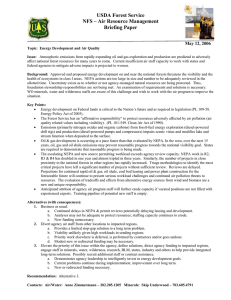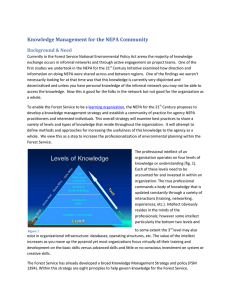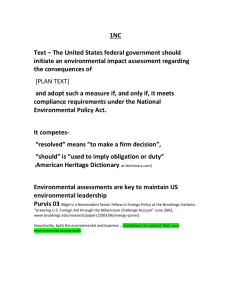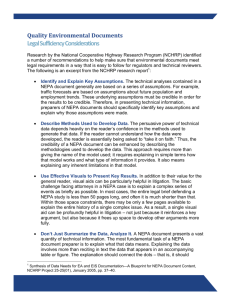NEPA for the 21st Century study summaries:
advertisement
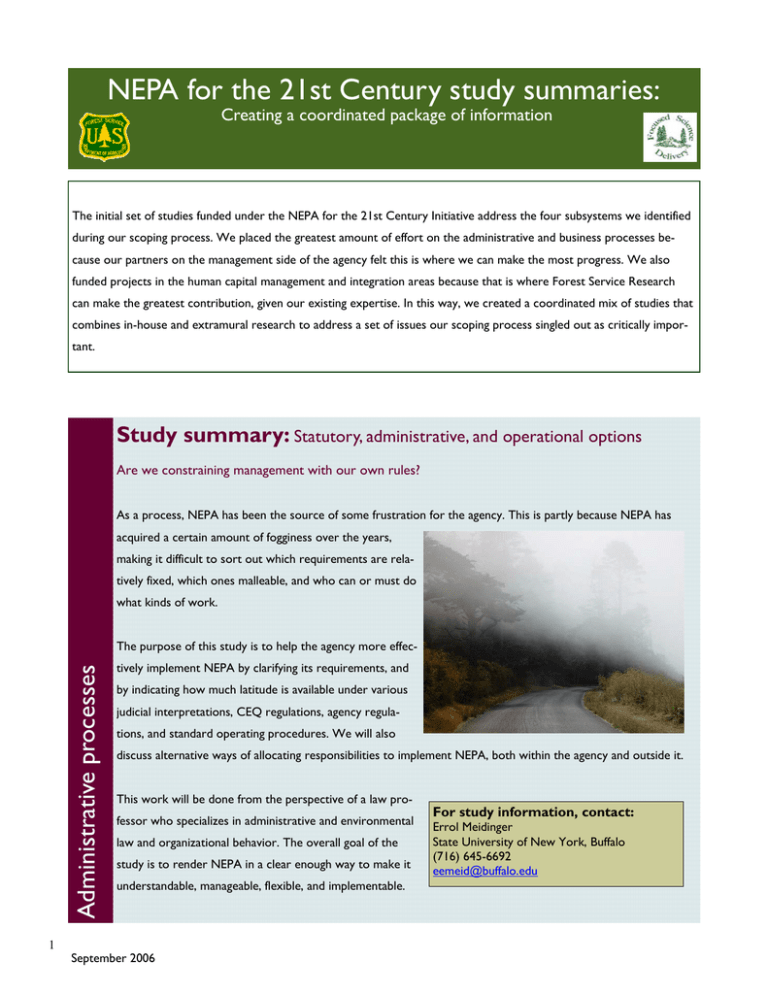
NEPA for the 21st Century study summaries: Creating a coordinated package of information The initial set of studies funded under the NEPA for the 21st Century Initiative address the four subsystems we identified during our scoping process. We placed the greatest amount of effort on the administrative and business processes because our partners on the management side of the agency felt this is where we can make the most progress. We also funded projects in the human capital management and integration areas because that is where Forest Service Research can make the greatest contribution, given our existing expertise. In this way, we created a coordinated mix of studies that combines in-house and extramural research to address a set of issues our scoping process singled out as critically important. Study summary: Statutory, administrative, and operational options Are we constraining management with our own rules? As a process, NEPA has been the source of some frustration for the agency. This is partly because NEPA has acquired a certain amount of fogginess over the years, making it difficult to sort out which requirements are relatively fixed, which ones malleable, and who can or must do what kinds of work. Administrative processes The purpose of this study is to help the agency more effec- 1 tively implement NEPA by clarifying its requirements, and by indicating how much latitude is available under various judicial interpretations, CEQ regulations, agency regulations, and standard operating procedures. We will also discuss alternative ways of allocating responsibilities to implement NEPA, both within the agency and outside it. This work will be done from the perspective of a law professor who specializes in administrative and environmental law and organizational behavior. The overall goal of the study is to render NEPA in a clear enough way to make it understandable, manageable, flexible, and implementable. September 2006 For study information, contact: Errol Meidinger State University of New York, Buffalo (716) 645-6692 eemeid@buffalo.edu Study summary: Factors influencing line officers’ decisions about NEPA project development How do we pick and manage the projects that become the focus of NEPA analyses? What information goes into making land management decisions and when do we actually make the decision? A resource management project is shaped by many factors, including agency directives, management targets, public desires and perceptions, and interactions among the administrative staff and the disciplinary specialists who define its main issues. The purpose of this study is to develop a clearer understanding of how projects evolve and progress from an initial concept into a formal NEPA analysis. Because ranger districts are a focal point for many resource management projects, we will concentrate our efforts at that level. This study will consist of in-depth interviews with a select group of 12-15 district rangers to gain perspective on their experiences navigating the NEPA process. Administrative processes We will ask them: 2 • What factors do you consider when selecting projects for analysis? • What information do you request for the analysis? • What information do you actually use in making a management decision? • When during the process does the decision actually happen, and how does the environmental analysis play into the decision? The interview process will allow each ranger to reflect on one or two projects that have been developed on their unit. We will probe for cues and information that describe how the project developed and how it was influenced by research findings, the interests of disciplinary specialists, public and political interests, and needs identified from resource planning. By carefully selecting the rangers we in- For study information, contact: Donald MacGregor MacGregor-Bates, Inc. including both successful and problematic experiences with the Eugene, OR NEPA process. Our objective is to identify points of commonality donaldm@epud.net terview, we will gain information about a variety of situations, as well as points of departure. September 2006 Study summary: Assessing literature related to Forest Service NEPA and environmental decision processes What can we learn from past evaluations of Forest Service NEPA processes? As the National Environmental Policy Act of 1969 nears the end of its fourth decade, we are interested in determining whether its current administrative processes are the most Administrative processes appropriate and efficient method of achieving the law’s objectives of improving consideration of environmental effects of proposed management actions and reducing their negative impacts. With that in mind, we will examine how NEPA has operated at the project level by conducting an archival analysis of pertinent administrative findings, congressional studies, selected agency reports, unpublished literature, and other available information on Forest Service NEPA and decision making processes. The analysis will summarize important findings from the literature, synthesize information on how Forest Service NEPA has operated at the project level, identify additional information needs, and discuss conclusions from our literature For study information, contact: Larry Ruth Lawrence Ruth and Associates Berkeley, CA (510) 541-6386 ergo@nature.berkeley.edu review. Study summary: Comparative analysis of NEPA process, organization, and personnel Do different Forest Service regions approach NEPA differently? Under its current practices, the Forest Service handles NEPA responsibilities in a highly decentralized manner with highly varied results. This leads to the question of whether there are differences in administration, structure, Business processes and personnel of the various Forest Service regions that might account for these disparate outcomes. This pro- 3 ject will provide a side-by-side comparison of two different regions, selected both for variation in characteristics and results and accessibility of information. We plan to gather information documenting the practices and structures of the two regions with respect to NEPA responsibilities. Based on an initial overview of this information, we will develop a list of key process, structure, and personnel factors that characterize how the regions deal with NEPA. We will look for notable differences in approach to these key factors, and then examine possible connections between these differences and project outcomes. This will provide a sense of how uniform the Forest Service system is from one region to another, and how effective various approaches are. September 2006 This analysis will provide important insights into some of the factors that can explain differences in NEPA results, For study information, contact: Ken Richards Matt Auer such as innovative decision-making tools on the positive School of Public and Environmental Affairs side, or lawsuits on the negative side. We will produce a Indiana University report on our methods, as well as a report explaining the Bloomington, IN Ken: (812) 855-5971, kenricha@indiana.edu side-by-side comparison of the two regions, including an Matt: (812) 855-4944, mauer@indiana.edu analysis of implications for explaining different NEPA outcomes. Study summary: Benchmarking analysis Under the same law, what do different agencies do differently? Agencies and organizations that manage land or water may vary widely in the ways they make decisions and navigate the NEPA process. The purpose of this study is to identify and compare NEPA processes across four federal land management agencies (the National Park Service, Army Corps of Engineers, the U.S. Forest Service, and the Bureau of Land Management). The key questions we will address include: How do NEPA procedures in the Forest Service compare with those of other federal agencies? How do different agencies define success within NEPA processes? What do they consider to be the strengths and weaknesses of their processes? We will conduct a review of NEPA guidance documents across agencies. This will be supplemented with interviews with process managers within each agency to uncover internal views of the benefits and disadvantages of different processes, successful and unsuccessful innovations, Business processes and different definitions of success. We will also describe the activities 4 associated with each agency’s NEPA processes, including the selection, articulation, and scoping of projects, staffing and organizational arrangements, public involvement, and document preparation. The information we collect will help us to build a framework for comparing NEPA processes across agencies. This may lend itself to developing different typologies for each of the major steps in the NEPA process. September 2006 For study information, contact: Marc Stern, (540) 231-7418, mjstern@vt.edu Michael Mortimer, (540) 231-1423, Mortimer@vt.edu Virginia Tech University Study summary: A protocol for the comparative analysis of environmental decision-making processes of other organizations How do other, non-federal organizations make environmental decisions? Though NEPA is a uniform law, there are many differences in how agencies conduct their NEPA processes. Many factors can shape an organization’s NEPA process, including funding availability, standard procedures, regulations, sources of innovation, and legal challenges. The purpose of this project is to develop a protocol that the Forest Service can use to conduct a comparative analysis of how other organizations, such as state agencies, NGOs, and businesses, comply with environmental laws, consider environmental impacts in their planning, make decisions, and implement their actions. This protocol will include a set of criteria for performance efficiency and policy effectiveness that provide a robust basis for assessing strengths and weaknesses in the implementation of environmental compliance by various agencies. We will structure our protocol to address the following questions: • What decision models are used for environmental decision making? • How efficient and effective are various environmental decision-making processes? • How do other organizations manage their environmental compliance processes and what efficiencies Business processes are gained? 5 This protocol will allow the Forest Service to analyze their own NEPA For study information, contact: Lisa Gaines process and other environmental compliance procedures in relation Associate Director Institute for Natural Resources to other organizations. In addition, we will include a final report that Oregon State University will contain a pilot comparative analysis of NEPA processes and per(541) 737-1976 lisa.gaines@oregonstate.edu formances of up to four state agencies, businesses, or NGOs. Study summary: New Institutional Economic Analysis of Forest Service NEPA responsibilities Are there other business models for reaching management goals that we can learn from? Currently, the Forest Service business approach to NEPA allows for the devolution or responsibilities to a large number of NEPA practitioners. This approach raises serious challenges, such as disparities between the goals of the regional staff and the larger organization, a lack of uniformity in products reaching the public, and the difficulty September 2006 a decentralized system has in adapting to organizational changes. The goal for this study is to apply the principles of New Institutional Economics to the overall design of the Forest Service’s NEPA process. The NIE approach focuses on how organizations are designed to best execute cooperative activities under different conditions. The unit of analysis is the “transaction,” or the task to be conducted. The optimal form of organization around a given task depends on things like the capacity to clearly define goals, Business processes the uncertainty in the surrounding environment, the extent of specialized investments required, the geographic spread of operations, and the frequency with which the task is repeated. We will examine different business models as alternative approaches to conducting NEPA within the Forest Service. We For study information, contact: Ken Richards Matt Auer School of Public and Environmental Affairs NEPA activities and evaluate them in terms of suitability for Indiana University various forms of organizational arrangements. We will review Bloomington, IN the results and develop a discussion of the implications for how Ken: (812) 855-5971, kenricha@indiana.edu Matt: (812) 855-4944, mauer@indiana.edu the Forest Service might structure its NEPA processes. will characterize the “transactions” involved in Forest Service Study summary: Survey of organizational change literature, including an analysis of systems change in the Forest Service How do organizations prepare for change? Organizations such as the Forest Service are steeped in tradition, and it is often difficult for them to make major changes in administrative or business processes. This is especially true when the change requires a substantial Human capital management restructuring of how work gets accomplished. Fortunately, there is a large and rich literature on organizational 6 change. Our study will summarize this literature, identifying common themes and highlighting the experiences of other agencies that have gone through substantial change. We will focus on specific methods, insights, and models that might be applicable to large-scale systems change in the Forest Service. In addition, we will produce a more in-depth report on the approach the Forest Service could take to successfully manage systems changes, especially as they might relate to the NEPA process. Questions we will address will include: How should a change effort be structured to deal with the specific culture of the Forest Service? How can a major change effort address the strong and sometimes conflicting political forces that impact the agency and surround the NEPA process? To develop this report, we will convene a twoday meeting of current and retired agency employees, September 2006 including line officers in the field and senior managers from the Washington Office. We will reflect on previous change efforts within the agency, analyze what contributed to their For study information, success or lack thereof, and determine the factors that seem neces- contact: sary for large-scale systems change to work in this agency. Our final Russ Linden Russ Linden & Associates report will include a framework for leading large-scale systems Charlottesville, VA russlinden@earthlink.net change in the Forest Service that could be applied to the NEPA www.russlinden.com process. Study summary: Evidence-based Management How can we create a corporate process for reducing uncertainty? Effective natural resource managers apply both their own personal expertise and the best available scientific evidence when making natural resource decisions. Alone, neither is enough. This integration of individual field expertise with scientific evidence from systematic research is called evidence-based natural resource management. To test and demonstrate the principles of this approach, we will start by identifying management issues that recur through many environmental analyses, like those encountered in the NEPA process. We will then assemble an interdisciplinary panel of private and public sector experts to review the latest science and debate the current body of knowledge on the chosen subject. The panel will note what is universally agreed upon, propose additional Human capital management research that may be needed, and publish its findings 7 in a peer-reviewed outlet. The purpose of such a review is to provide the best available research on the likely outcomes of various actions. The end result will be a comprehensive package of information on a particular land management issue. By providing an independent, unbiased assessment of evidence, this becomes a decision support tool that can be used to inform the natural resource decisions of managers, the courts, and policy makers. One of the strengths of this information-gathering system is that it takes a multi-disciplinary approach, combining the latest science from both public and private research. It will also bring the latest knowledge in resource management together with longer-term research, to paint a bigger picture of trends and put important issues in context. September 2006 For study information, contact: Michael Goergen Society of American Foresters Bethesda, MD (310) 897-8720 x120 GoergenM@safnet.org Project summary: Workshop to examine the integration of NEPA processes: Creating an easy transfer of knowledge and bringing the whole project together We are interested in collaborating with the other studies in this project to integrate information about innovative ways to conduct environmental analyses and implement environmental policy. With that in mind, we will develop a workshop that will draw on the accumulated knowledge of experts in conducting NEPA analyses and making environmental decisions. The format of this workshop will involve interactive dialogues rather than presentations of papers to a passive audience. We will use a structured process that keeps discussions on topic, since experience has shown that this is the most productive way to solicit information. Approximately 10 Forest Service personnel (including both agency NEPA experts and line officers) and 10 nonagency experts will attend. The small number of participants will also help maximize productive conversation. The primary focus of the workshop will be the research results from the NEPA for the 21st Century Project. Prior to the workshop, summaries of results will be sent to participants. Our goal is to steer conversations around how best to apply research results toward devising new, more effective, and publicly responsible ways of fulfilling NEPA obligations. Finally, we will synthesize the results of the workshop in a final report. Integration The workshop is scheduled for the week of March 19, 2007. For workshop information, contact: Hanna J. Cortner Cortner and Associates Research (928) 526-1514 hannacortner@aol.com NEPA for the 21st Century: Learning, adjusting, and solving problems 8 September 2006
